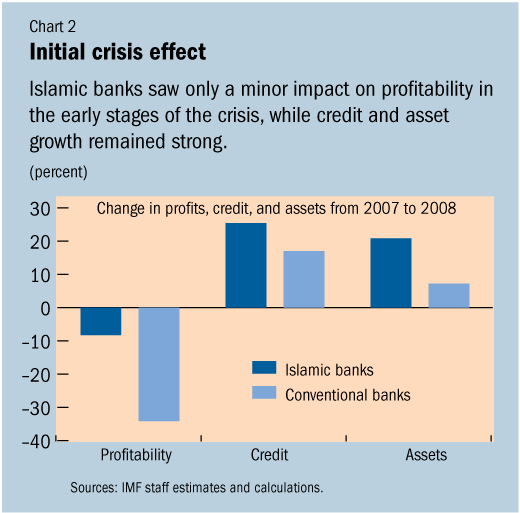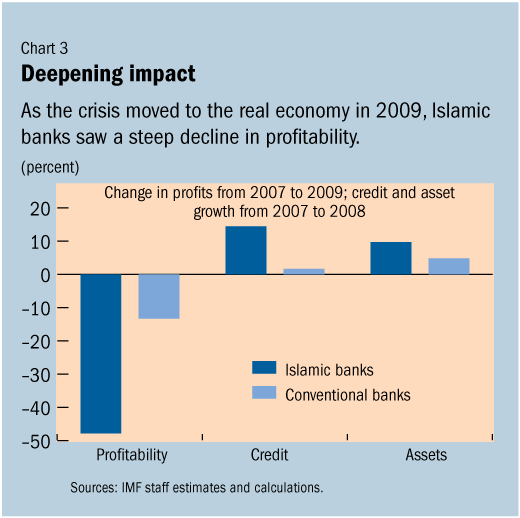Also see : http://islamicfinanceturkey.blogspot.com/2010/09/since-global-financial-crisis-started.html
Also see : http://islamicfinanceturkey.blogspot.com/2010/09/articles-imf-effects-of-global-crisis.html
A new IMF study compares the performance of Islamic banks and conventional banks during the recent financial crisis, and finds that Islamic banks, on average, showed stronger resilience during the global financial crisis.
But the study also finds that Islamic banks faced larger losses than their conventional peers when the crisis hit the real economy.
In “The Effects of the Global Crisis on Islamic and Conventional Banks: A Comparative Study,” economists Jemma Dridi of the IMF’s Middle East and Central Asia Department and Maher Hasan of the IMF’s Monetary and Capital Market Department look at the effects of the crisis on bank profitability, credit, and asset growth in countries where both types of banks have a significant market share. The new working paper adds an empirical dimension to the debate on the relationship between Islamic banking and financial stability, a topic that has generated renewed interest since the global crisis.
Too big to ignore
Islamic finance is one of the fastest growing segments of the global financial industry. In some countries, it has become systemically important and, in many others, it is too big to be ignored. It is estimated that the size of the Islamic banking industry at the global level was close to $820 billion at end-2008. The largest Islamic banks are located in the countries of the Gulf Cooperation Council (Bahrain, Kuwait, Oman, Qatar, Saudi Arabia, and the United Arab Emirates).
While Islamic banks play roles similar to conventional banks, fundamental differences exist between the two models. The main difference between Islamic and conventional banks is that the former operate in accordance with the rules of Shariah, the legal code of Islam. The central concept in Islamic banking and finance is justice, which is achieved mainly through the sharing of risk. Stakeholders are supposed to share profits and losses, and charging interest is prohibited.
There are also differences in terms of financial intermediation, the paper notes. While conventional intermediation is largely debt based, and allows for risk transfer, Islamic intermediation, by contrast, is asset based, and centers on risk sharing. One key difference between conventional banks and Islamic banks is that the latter’s model does not allow investing in or financing the kind of instruments that have adversely affected their conventional competitors and triggered the global financial crisis. These include toxic assets, derivatives, and conventional financial institution securities.
Crisis impact
To control for varying conditions across financial systems, the paper looks at the actual performance of Islamic banks and conventional banks in countries where both have significant market shares (see Chart 1). It uses bank-level data covering 2007−10 for about 120 Islamic banks and conventional banks in eight countries—Bahrain, Jordan, Kuwait, Malaysia, Qatar, Saudi Arabia, Turkey, and the United Arab Emirates. These countries host most of the world’s Islamic banks (more than 80 percent of the industry, excluding Iran) but also have large conventional banking sectors. The key variables used to assess the impact are the changes in profitability, bank lending, bank assets, and external bank ratings.

The analysis suggests that Islamic banks fared differently from conventional banks during the global financial crisis. Factors related to the Islamic banking business model helped contain the adverse impact on their profitability in 2008 (see Chart 2). In particular, smaller investment portfolios, lower leverage, and adherence to Shariah principles—which precluded Islamic banks from financing or investing in the kind of instruments that have adversely affected their conventional competitors—helped contain the impact of the crisis on Islamic banks in that year.

The following year, however, weaknesses in risk management practices in some Islamic banks led to a larger decline in profitability compared to that seen in conventional banks (see Chart 3). The weak 2009 performance in some countries was associated with sectoral and name concentration—that is, too great a degree of exposure to any one sector or borrower. In some cases, the problem was made worse by exemptions from concentration limits, highlighting the importance of having a neutral regulatory framework for both types of banks.
Despite the higher profitability of Islamic banks during the pre-global crisis period (2005–07), their average profitability for 2008–09 was similar to that of conventional banks, indicating better cumulative profitability and suggesting that higher pre-crisis profitability was not driven by a strategy of greater risk taking. The analysis also shows that large Islamic banks fared better than small ones, perhaps as a result of better diversification, economies of scale, and stronger reputation. Development of the industry might therefore be achieved, the paper suggests, through establishing large, well-managed Islamic banks that can compete with existing banks.

Source of stability
Islamic banks contributed to financial and economic stability during the crisis, given that their credit and asset growth was at least twice as high as that of conventional banks. The paper attributes this growth to their higher solvency and to the fact that many Islamic banks lent a larger part of their portfolio to the consumer sector, which was less affected by the crisis than other sectors in the countries studied. These findings were corroborated by external rating agencies’ reassessment of Islamic banks’ risk, which was generally found to be more favorable than—or similar to—that of conventional banks.
In view of their robust growth during the crisis, Islamic banks will likely take a growing market share in the future—but this implies greater supervisory responsibility, the authors note.
Challenges revealed
While the global crisis gave Islamic banks an opportunity to prove their resilience, it also brought to light some important challenges. Going forward, the authors say, the industry will need to focus on the following priorities:
• building a well-functioning infrastructure for liquidity management;
• ensuring that the supervisory and legal infrastructure, including for bank resolution, remains relevant in the rapidly changing Islamic financial landscape;
• aligning reform efforts with the global financial regulatory reform agenda; and
• harmonizing regulations and products to foster the efficient and sustainable growth of the Islamic banking industry.
To address these challenges, Islamic banks and supervisors will have to work together to develop the needed human capital, since expertise in Islamic finance has not kept pace with the industry’s growth, the authors say.• ensuring that the supervisory and legal infrastructure, including for bank resolution, remains relevant in the rapidly changing Islamic financial landscape;
• aligning reform efforts with the global financial regulatory reform agenda; and
• harmonizing regulations and products to foster the efficient and sustainable growth of the Islamic banking industry.
Source : http://www.imf.org/external/pubs/ft/survey/so/2010/RES100410A.htm - Oct 4, 2010
